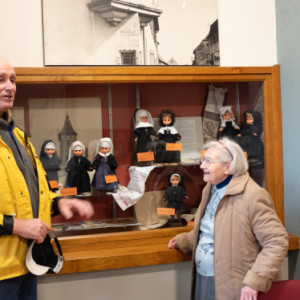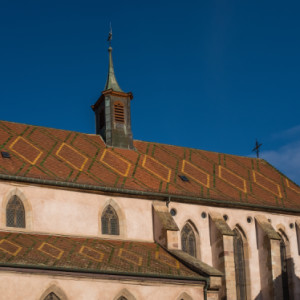Deconstructed at the convent
Today, we went to visit my aunt (the nun)'s convent as I thought its history might be of interest to hubby. And it didn't disappoint.
First, the meaning of the picture: it's a "deconstructed" stained glass window, which was prepared for the convent by a local artist to thank the congregation. The words on its pieces represent the philosophy of the congregation.
Next, a bit of history. The congregation (les Soeurs de la Divine Providence de Ribeauvillé) was started in 1793 by Father Kremp to respond to an urgent need at the time: the free education of girls, particularly country girls (back in the days, only boys got to go to school and often had to pay for it). The congregation was formally established in 1819 (about to celebrate its bi-centennial) in a monastery of former Augustin monks built in the 13th century, donated to the sisters by some good samaritans.
It went through several upheavals: first the French revolution (1789) when all things religion became suspect and priests as well as nuns were to proclaim allegiance to the new constitution or find themselves in prison. The congregation's nuns refused to do so and fled instead to Switzerland. You had to have a "passport" at the time to do so, which none of them had. One sister figured that most people at the time didn't know how to read or write, so they grabbed some other official looking paper and at the first stop put it to the test. When, as expected, the official didn't know what he was looking at, he approved the papers. The nuns then cleverly asked him to put an official stamp on it ("in case your colleagues can't read") and they had safe passage after that. Ah, the ingenuity of women ;)
By the end of the 19th century, a majority of girls were instructed in schools by the sisters of the congregation.
They went through another upheaval when Alsace was annexed by Germany in 1870. Bismarck's regime didn't believe in nuns teaching, so they were asked to leave the many public schools in which they were teaching. Again, and with the support of locals, they refused. They ended up outlasting Bismarck :) During that time, they were the first to print school books for the children; not only that, but they did so in two languages: one page German, the opposite page French. The sisters were determined to preserve the cultural heritage and incorporate the cultures.
A similar situation happened during WW2 when the Nazis occupied the region. Again, the sisters refused to relinquish their duties and continue teaching.
There are clever little touches throughout the convent, reflecting the nature of their mission: the main altar of their church depicts Christ surrounded not by men or a mixture of men and women, but solely women; there is a sculpture of Joseph reading to a young Jesus (a very unique take); there's a painting of Christ's resurrection and descent into limbo where he doesn't raise Adam, but rather Eve. And finally the main stained glass window in the church depicts Christ not on a cross but on a vine, whose offshoots reach God -- a tribute to the area's long wine making tradition (and yes, the congregation owns vineyards which they now sublet to a producer).
There were so many stories told by the 87-yr old nun who is the convent's historian that seemed to show that these nuns were really feminists way before that word ever crossed anyone's lips and ready to go to battle for what they believed in. Too many to recount here but I'll treasure the memories :)
I've added several extras: a collection of dolls that shows the evolution of the nuns' habits; the stained glass window; the outside of the church; an exhibit that shows the materials used by the teachers (including the printed books); a collection of teaching plates; and the altar sculpture featuring Christ surrounded by women (all saints, of course...)




Comments
Sign in or get an account to comment.


